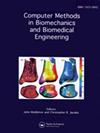The biomechanical injury calculator: a postprocessor software for a finite element human body model.
IF 1.7
4区 医学
Q3 COMPUTER SCIENCE, INTERDISCIPLINARY APPLICATIONS
Computer Methods in Biomechanics and Biomedical Engineering
Pub Date : 2025-04-23
DOI:10.1080/10255842.2024.2448554
引用次数: 0
Abstract
An injury risk assessment postprocessor for the Global Human Body Model Consortium (GHBMC) model is presented. The Biomechanical Injury Calculator (BIC) calculates injury probabilities for the head, neck, spine, and pelvis post-simulation, along with a total injury probability for the entire complex. It also generates an injury heatmap. Developed for the GHBMC M50-OS v2.3 +DeformSpine, BIC was validated by comparing 103 airmen's seat ejection injuries to BIC-predicted injury probabilities in 30 vertical seat load simulations. Observed injury rates correlated strongly with BIC predictions (Spearman=0.943, Pearson=0.982) within 5.16% margin. The total injury probability of 58.48% closely matched the 56.3% observed rate.
生物力学损伤计算器:一种有限元人体模型的后处理软件。
提出了一种适用于全球人体模型联盟(GHBMC)模型的损伤风险评估后处理器。生物力学损伤计算器(BIC)计算头部、颈部、脊柱和骨盆在模拟后的损伤概率,以及整个建筑群的总损伤概率。它还能生成损伤热图。BIC是为GHBMC M50-OS v2.3 +DeformSpine开发的,通过将103名飞行员的座椅弹射伤害与BIC预测的30个垂直座椅载荷模拟中的伤害概率进行比较,对BIC进行了验证。观察到的损伤率与BIC预测的相关性强(Spearman=0.943, Pearson=0.982),差值在5.16%以内。58.48%的总损伤概率与56.3%的观察率基本吻合。
本文章由计算机程序翻译,如有差异,请以英文原文为准。
求助全文
约1分钟内获得全文
求助全文
来源期刊
CiteScore
4.10
自引率
6.20%
发文量
179
审稿时长
4-8 weeks
期刊介绍:
The primary aims of Computer Methods in Biomechanics and Biomedical Engineering are to provide a means of communicating the advances being made in the areas of biomechanics and biomedical engineering and to stimulate interest in the continually emerging computer based technologies which are being applied in these multidisciplinary subjects. Computer Methods in Biomechanics and Biomedical Engineering will also provide a focus for the importance of integrating the disciplines of engineering with medical technology and clinical expertise. Such integration will have a major impact on health care in the future.

 求助内容:
求助内容: 应助结果提醒方式:
应助结果提醒方式:


